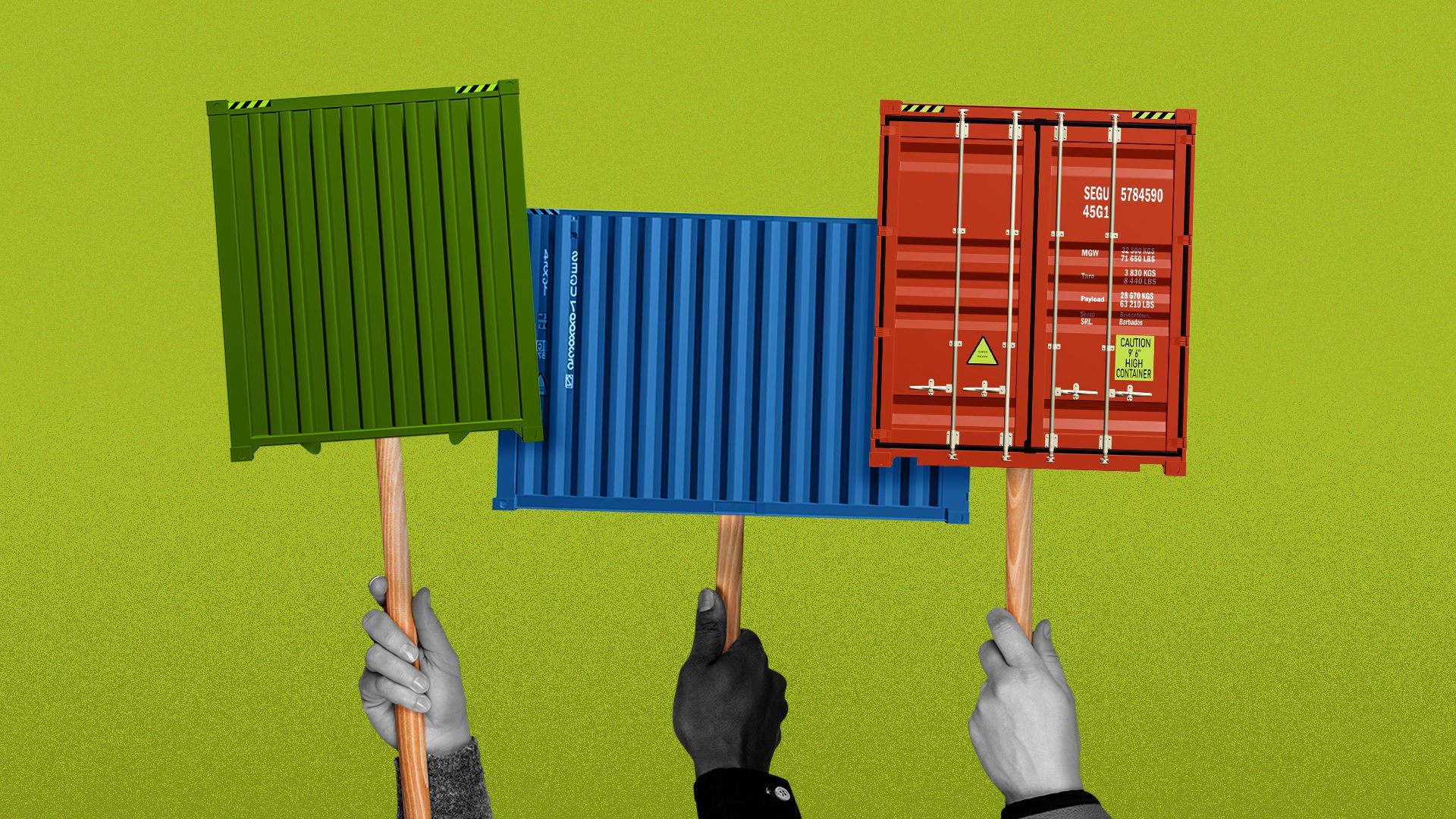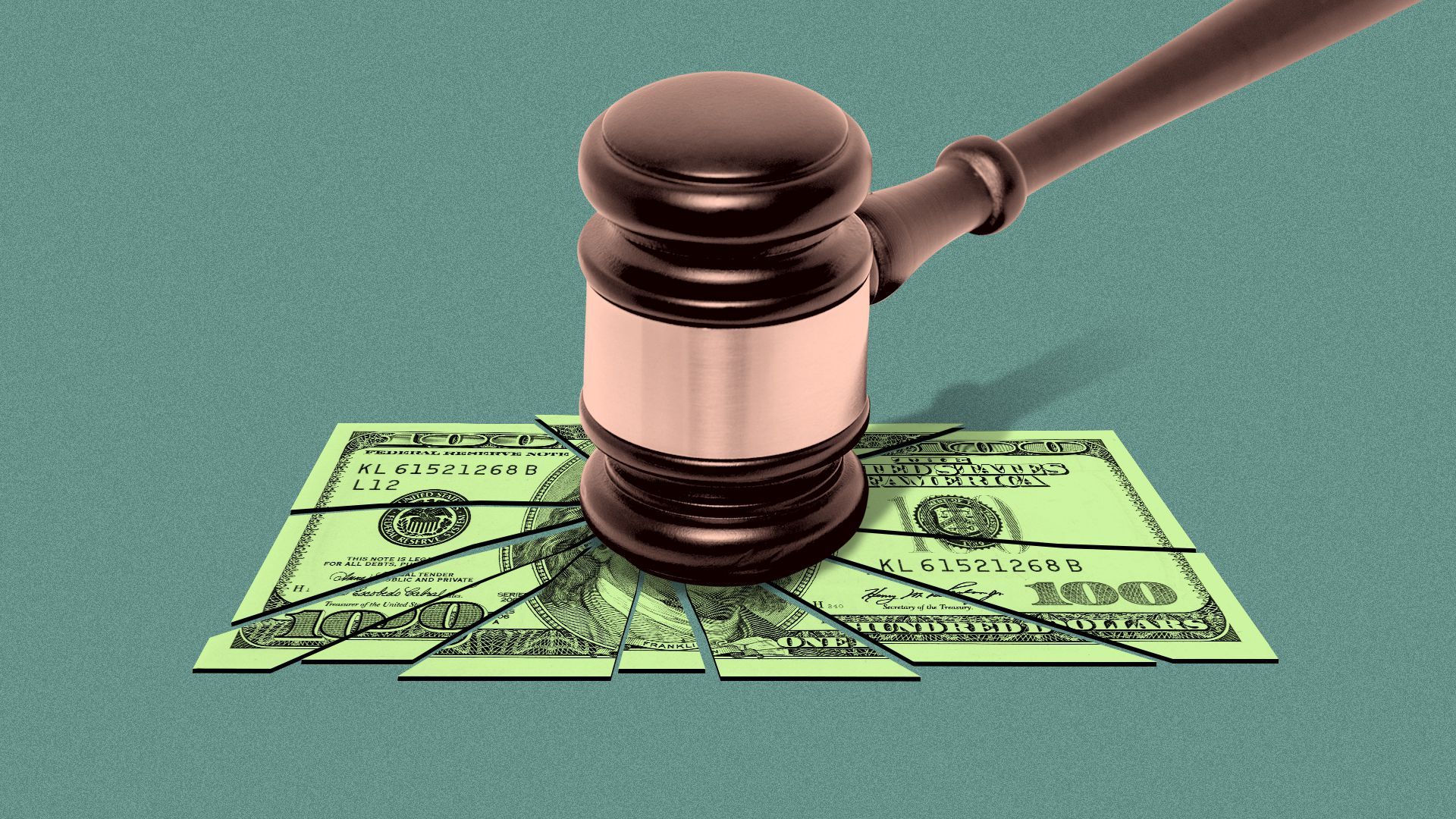| | | | | | | Presented By The Northern Trust Institute | | | | Axios Markets | | By Emily Peck and Matt Phillips · Sep 12, 2022 | | Welcome to a new week, where the key market-moving event will likely be the release of tomorrow's CPI inflation report. Let's get to it. Today's newsletter is 1,084 words, 4.5 minutes. | | | | | | 1 big thing: Strikes could threaten fragile supply chain recovery |  | | | Illustration: Allie Carl/Axios | | | | Two huge labor disputes, in the railways and at the ports, threaten to re-tangle supply chains in the U.S. And the White House is pushing to avert disaster, engaged at a level not seen in decades, Emily writes. Why it matters: The stakes are sky-high economically. A shutdown of the nation's rail system could cost $2 billion a day, according to an industry estimate, and we've already seen what backed-up ports do to the economy. - Politically, any work stoppage would spell disaster for a pro-labor White House determined to keep inflation in check and avert bottlenecks.
- "A shutdown of our freight rail system is an unacceptable outcome for our economy and the American people," a White House official said in a statement to Axios over the weekend. "The Administration has been actively engaged, pushing for a resolution."
Driving the news: Over the weekend, negotiations continued between the country's largest freight railroad companies — including Berkshire Hathaway's BNSF, Union Pacific and CSX — and the majority of the unions representing around 115,000 workers. - They're racing to meet a Friday deadline when a "cooling off period" runs out and workers could strike.
- Meanwhile, port workers on the West Coast have been negotiating a new contract; the last one expired in June.
Zoom out: The freight railway "serves nearly every agricultural, industrial, wholesale, retail and resource-based sector of the economy," explains the industry's trade group in a paper. - If the rails grind to a halt, it would be left to the nation's trucking system to pick up the slack — that'd be costly and there isn't enough capacity to handle all the extra stuff.
- The American Trucking Associations, a trade group is urging Congress to step in if negotiations fail, Reuters reported.
- Separately, an 11-day lockout at the ports back in 2002 cost the U.S. economy $11 billion at that time, the New York Times noted recently.
Zoom out: In the modern era, the White House typically stays out of labor negotiations — maybe just swooping in at the last moment to help sides reach a resolution. But the Biden administration is working differently in these disputes — and not just because this president has been so vocal about his support for unions. - "The supply chain crisis put the ports and the railroads on the radar screen," says Geraldine Knatz, executive director of the Port of Los Angeles from 2006 to 2014.
- The White House in May appointed a "port czar" to keep an eye on the supply chain. That's not something that's happened "during my time," says Knatz, now a professor of policy and engineering at USC.
|     | | | | | | 2. Catch up quick | | 🇺🇸 Biden to broaden curbs on U.S shipments to China of chips and tools. (Reuters) 💶 Euro surges against the dollar on rate outlook and Ukraine gains. (Bloomberg) 💳 Credit card sales at gun stores to be tracked with new merchant code. (WSJ) |     | | | | | | 3. A bankruptcy case to watch |  | | | Illustration: Brendan Lynch/Axios | | | | A bankruptcy case in Indiana could help upend the U.S. litigation system, Axios' Kate Marino writes. Driving the news: 3M, the conglomerate, recently put its Aearo Technologies subsidiary into bankruptcy. It aims to use the bankruptcy process to settle over 230,000 lawsuits from military service members who allege faulty earplugs made by Aearo caused hearing loss — the biggest multi-district litigation (MDL) in history. Why it matters: Aearo's rationale for the bankruptcy involves questioning whether the U.S. mass tort and MDL system is even functional, calling its own experience "a cautionary tale of a MDL that is broken beyond repair." (Reuters has more.) - And large companies regularly exposed to mass torts — think pharma and medical device makers — are closely watching what happens with both Aearo and last year's bankruptcy of a Johnson & Johnson subsidiary. The latter was filed to help settle baby powder litigation and is the second largest MDL in history.
- The outcomes could provide a playbook for large, profitable parent companies — which don't appear to be insolvent — to take advantage of certain features of the bankruptcy process without actually filing for bankruptcy themselves.
- In other words: The benefits of bankruptcy, without the drawbacks.
The benefits: Bankruptcy provides an efficient route to settling with a sprawling group of claimants. - Instead of plodding through thousands of individual cases, the bankruptcy court estimates the liability via expert testimony and bellwether verdicts so far and facilitates settlement negotiations if the company doesn't have the money.
- Often, bankrupt entities get an "automatic stay" (or pause) of litigation against them, which prevents additional unfavorable trial verdicts from rolling in — and can thus give them more leverage in settlement talks.
The drawbacks: Bankrupt companies come under court control for day-to-day financial decisions. They typically wouldn't be able to transfer value to shareholders with actions like spinoffs — as 3M is currently planning to do. What they're saying: After the J&J case last year, "the flood gates are open," wrote Georgetown Law professor Adam Levitin on the Credit Slips blog. - In Levitin's view, "like J&J, 3M appears solvent and capable of paying all of the hearing claims in full. So instead, it is hoping to use bankruptcy to be the forum for forcing a deal on plaintiffs."
What to watch: So far, the bankruptcy judge isn't totally going along with it — he refused to stay the litigation against 3M. The company's appealing. Read more. |     | | | | | | A message from The Northern Trust Institute | | Market Currents Podcast: Listen now | | |  | | | | Market Currents, a new podcast from the Northern Trust Institute, explores today's most hotly debated investment topics. Join host Katie Nixon as she interviews industry experts to investigate the evidence on both sides. Listen now, wherever you get your podcasts. | | | | | | Bonus chart: 3M's equity swoon |  Data: FactSet; Chart: Axios Visuals 3M's stock has underperformed since the earplug lawsuits began in 2018, which analysts attribute in part to the potential liability. |     | | |  | | | | If you like this newsletter, your friends may, too! Refer your friends and get free Axios swag when they sign up. | | | | | | | | 4. ⛽️ Gas prices keep plunging |  Data: U.S. Energy Information Administration; Chart: Axios Visuals Gasoline prices continue to tumble throughout the U.S., taking the starch out of the stiff rise in inflation and cheering up consumers, Matt writes. Why it matters: Average national gasoline prices hit $5.02 a gallon back in June, amplifying the national fixation on inflation. Driving the news: According to AAA, a gallon of regular was an average of $3.72 on Friday, more than 25% lower than the June peak. Yes, but: Not everyone's experience at the pump will mirror the national average. - California typically has some of the most expensive gas because the state requires refiners to produce a blend that meets more stringent anti-pollution requirements than much of the rest of the country.
- California also has higher than average gasoline taxes, which add to the cost at the pump.
What we're watching: The futures prices for "reformulated blendstock for oxygenate blending," or RBOB. This wholesale gasoline benchmark tends to move in advance of the retail gasoline prices you see while filling up. - It's down more than 10% in the last 10 trading sessions, suggesting lower retail prices are still to come.
|     | | | | | | A message from The Northern Trust Institute | | Create value from values | | |  | | | | Do ESG investments deliver on their promise? Investors worry about sacrificing returns or whether their investments will make a difference. Next steps: Explore how Northern Trust can build a plan that reflects your values and achieves what's most important to you. Learn more. | | | | 1 thing Matt loves: revelations. One came recently, as I was listening to a podcast. I learned that the name Lusitania — as in "Remember the Lusitania!" — was actually the name of the Iberian Roman province that corresponds roughly to what we know as Portugal today. Never knew that! (Apparently, the Cunard Line, which owned the ship that was sunk by German U-boats in 1915, liked to name ships after Roman provinces.) This newsletter was edited by Kate Marino, and copy edited by Mickey Meece. |  | | Why stop here? Let's go Pro. | | | | | | Axios thanks our partners for supporting our newsletters. If you're interested in advertising, learn more here.
Sponsorship has no influence on editorial content. Axios, 3100 Clarendon Blvd, Arlington VA 22201 | | | You received this email because you signed up for newsletters from Axios.
Change your preferences or unsubscribe here. | | | Was this email forwarded to you?
Sign up now to get Axios in your inbox. | | | | Follow Axios on social media:    | | | | | |












No comments:
Post a Comment